|
Sony FE 20-70mm f/4 G - Review / Test Report |
|
Lens Reviews -
Sony Alpha (Full Format)
|
Review by Klaus Schroiff, published May 2023

Introduction
For decades, full-format standard zoom lenses have been confined to the 24-XX or 28-XXmm range. This only changed very recently in 2020 when Panasonic released their Lumix S 20-60mm f/3.5-5.6 lens. The Panasonic lens was quite an innovation because conventional standard zoom lenses are already hard to design, and a 20-60mm is on an even higher complexity level while remaining quite affordable. It took Sony no less than 3 years to come up with their own interpretation of the topic - the Sony FE 20-70mm f/4 G. Unlike the Panasonic lens, it is targeting a more upmarket consumer segment which is also reflected in a very different price tag of around 1100USD/1500EUR. While it may feel quite steep, it is in line with Sony's FE 24-105mm f/4 G OSS. So if you are shopping in this price class, you can choose between an emphasis on the wide- or tele-end. Both lenses are members of Sony's G-lineup, which balance both costs and quality and are the natural place to be for most enthusiasts. Sony's G-class lenses are a major differentiator in our book - other manufacturers only follow a two-lens-grade (bottom + high-end) strategy.
 The G-class designation also means that Sony didn't compromise on build quality. While the lens body is made of plastics (on a metal mount), it is a high-quality variant that feels solid.
Despite the very low weight of the lens, it feels "dense," and there's no wobbling of the inner zoom tube even when fully extended. The zoom and focus ring actions are smooth.
Needless to say, Sony incorporated some sealing again dust and moisture. A fluorine coating in the front element also helps to repel fluids and particles.
Given the fact that video is becoming ever more important, Sony also implemented an aperture click switch, an iris lock and breathing compensation is supported if the camera is capable of doing so.
A petal-shaped lens hood is part of the package.
The G-class designation also means that Sony didn't compromise on build quality. While the lens body is made of plastics (on a metal mount), it is a high-quality variant that feels solid.
Despite the very low weight of the lens, it feels "dense," and there's no wobbling of the inner zoom tube even when fully extended. The zoom and focus ring actions are smooth.
Needless to say, Sony incorporated some sealing again dust and moisture. A fluorine coating in the front element also helps to repel fluids and particles.
Given the fact that video is becoming ever more important, Sony also implemented an aperture click switch, an iris lock and breathing compensation is supported if the camera is capable of doing so.
A petal-shaped lens hood is part of the package.
 Two XD (extreme dynamic) Linear Motors provide very fast and silent autofocusing. Manual focusing works, of course, "by wire". A rather usual feature of the Sony lens is its close focus capacity. A max magnification of 1:2.5 may not be true macro territory yet, but it's far better than the class average. Sony didn't implement an optical stabilizer. Some may consider this a drawback, but based on our experience, it's a good thing. As hinted above, this is a complex design, and throwing even more ingredients into the soup doesn't make it any better, especially regarding long-term durability (consistent centering).
Two XD (extreme dynamic) Linear Motors provide very fast and silent autofocusing. Manual focusing works, of course, "by wire". A rather usual feature of the Sony lens is its close focus capacity. A max magnification of 1:2.5 may not be true macro territory yet, but it's far better than the class average. Sony didn't implement an optical stabilizer. Some may consider this a drawback, but based on our experience, it's a good thing. As hinted above, this is a complex design, and throwing even more ingredients into the soup doesn't make it any better, especially regarding long-term durability (consistent centering).
| Specifications |
|---|
| Optical construction | 16 Elements in 13 Groups (2x AA, 1x aspherical, 1x ED-aspherical, 2x ED elements) |
| Number of aperture blades | 9 (rounded) |
| min. focus distance | 0.25m (max magnification: 1:2.5) |
| Dimensions | 78.7x99mm |
| Weight | 488g |
| Filter size | 72mm |
| Hood | petal-shaped (bayonet mount, optional) |
| Focus-breathing compensation | supported |
| Other features | aperture ring, iris-lock, focus-lock buttons, aperture click switch, dust- and moisture-resistent |
Distortion
Two aspects can explain why the Sony FE 20-70mm f/4 G has not been designated as a GM lens - one of them is image distortions. At 20mm, the RAW image distortions are extreme at almost 9(!)% - and you should remember that distortion correction is lossy. The barrel distortions decrease to just over 3% at 28mm and go neutral in the middle of the range. At 70mm, images exhibit medium pincushion distortion.
With activated auto-correction, these worries are mostly gone. At 20mm, there is merely a trace of barrel distortion left, and they are gone at other settings.
Vignetting
Given the extreme level of image distortions, the native vignetting characteristic is somewhat better than expected. The vignetting is high (1.8 f-stops) at 20mm f/4 but not excessive. At other focal lengths, the issue is much reduced- which is a bit too good to be true. Some trickery under the hood seems likely.
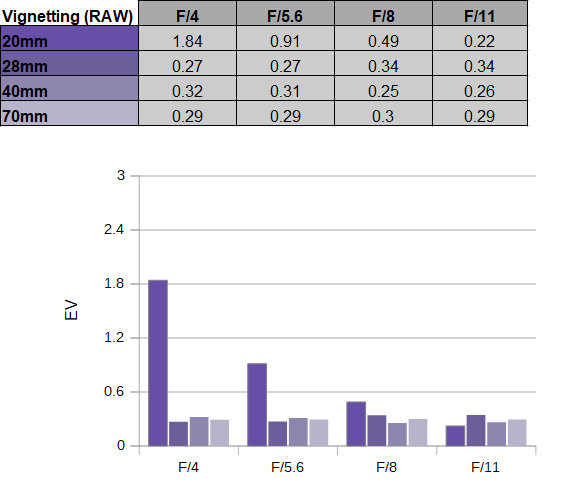 Once again, image auto-correction comes to the rescue. It is quite aggressive, resulting in rather low vignetting figures at all relevant settings.
Once again, image auto-correction comes to the rescue. It is quite aggressive, resulting in rather low vignetting figures at all relevant settings.

MTF (resolution at 42 megapixels)
The most interesting image characteristic in this lens class is sharpness. The MTFs below were obtained with ACTIVATED distortion compensation - because using this lens without isn't really a use case. Overall, the results are still pretty impressive. The center performance is excellent throughout the zoom zoom range, with higher peaks towards the wide end. The near-center performance is also very good. The image auto-correction takes a certain toll in the outer image field at 20mm, where the quality drops to good to very good levels. That's still pretty decent for a 20mm lens - and on a zoom lens anyway. The borders/corner quality increases somewhat between 28 and 70mm. As usual, diffraction has a higher impact from f/11, but the setting remains usable. f/16 should be avoided unless you really need the extra depth-of-field.
Please note that the MTF results are not directly comparable across the different systems!
Below is a simplified summary of the formal findings. The chart shows line widths per picture height (LW/PH) which can be taken as a measure of sharpness.
If you want to know more about the MTF50 figures, you may check out the corresponding Imatest Explanations

Chromatic Aberrations (CAs)
Lateral CAs (color shadows in the outer image field) are quite well-corrected. Unsurprisingly, they are most pronounced at 20mm with an average pixel width of around 1.2px at the image borders. The CAs decrease a bit when zooming toward longer focal lengths.

Bokeh (out of focus blur)
Standard zoom lenses are almost never good performers regarding the bokeh quality. It tends to get increasingly worse with the number of aspherical elements in the optical design. And yes, the Sony FE 20-70mm f/4 G also has its share of issues here.
Out-of-focus highlights don't look too bad, actually. The inner zone of the discs is slightly nervous but not significant outlining.
 The shape of the highlights tends to deteriorate towards the image corners. However, a big surprise here - the Sony lens is barely affected by this common effect. The corner highlights may not be perfectly circular, but it's basically the next best thing. Stopping down to f/5.6 fixes these imperfections slightly, and the corner discs are almost perfect at f/8.
The sample shot below illustrates the 2nd major issue of the lens - the background bokeh (shown to the left below). It's bad. There is no other word for it. The foreground blur (to the right) is relatively smooth in comparison.
The shape of the highlights tends to deteriorate towards the image corners. However, a big surprise here - the Sony lens is barely affected by this common effect. The corner highlights may not be perfectly circular, but it's basically the next best thing. Stopping down to f/5.6 fixes these imperfections slightly, and the corner discs are almost perfect at f/8.
The sample shot below illustrates the 2nd major issue of the lens - the background bokeh (shown to the left below). It's bad. There is no other word for it. The foreground blur (to the right) is relatively smooth in comparison.
 These are lab results, but how do they translate to real life? Below are two sample crops taken from our sample images (next page). The top one is a bit on the extreme side regarding lighting, but you can see that the out-of-focus discs of the water drops are doughnut-like here. However, remember that the effect is far less obvious if the contrasts aren't quite as harsh.
The bottom image illustrates the rough background blur we were referring to before. This looks hardly ideal.
These are lab results, but how do they translate to real life? Below are two sample crops taken from our sample images (next page). The top one is a bit on the extreme side regarding lighting, but you can see that the out-of-focus discs of the water drops are doughnut-like here. However, remember that the effect is far less obvious if the contrasts aren't quite as harsh.
The bottom image illustrates the rough background blur we were referring to before. This looks hardly ideal.

Sun Stars (Experimental)
Below is s sequence of 100% cropped images from 20mm f/4 all the way up to f/16 - illustrating the sun star behavior. Sun stars are an aperture effect that shows up if a bright light source is part of the scene (usually in night shots) - here, formally illustrated using an LED. Due to the circular aperture shape, the sun stars are very underdeveloped at f/4 and f/5.6. They are getting more pronounced at f/8 and are nicely pointy at f/11 and f/16.
Flare
All lenses struggle to a certain degree when shooting directly into a strong light source, and it's difficult to quantify in numbers. Below is a rather extreme example of shooting directly into the sun (and yes, normally, you won't take such a shot in the first place). However, even so, the Sony lens produces only a minimal amount of ghosting - you may spot a greenish spot within the red circle in the image below. Overall, we'd rate the flare resistance as clearly above average for a standard zoom lens.

Sample Images
Click on an image to download the full-size variant (RAW images converted via DxO Photolab 6).
 |
| Make | SONY |
| Model | ILCE-7RM5 |
| ISO Speed | 640 |
| Focal Length | 20.0mm |
| Aperture: | f/4.0 |
| Exposure | 1/15s |
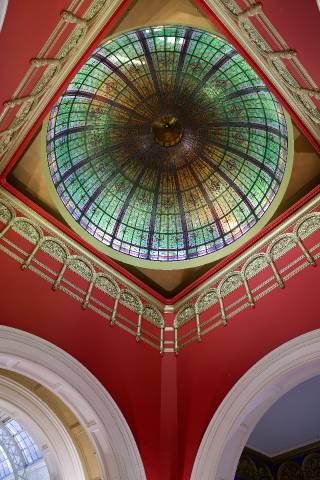 |
| Make | SONY |
| Model | ILCE-7RM5 |
| ISO Speed | 640 |
| Focal Length | 21.0mm |
| Aperture: | f/4.0 |
| Exposure | 1/15s |
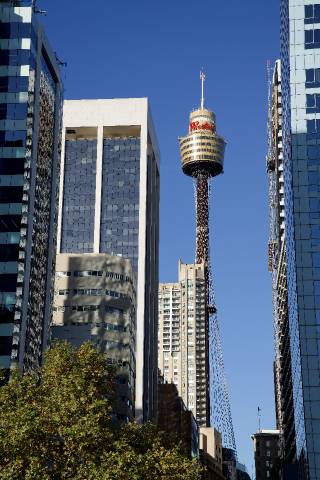 |
| Make | SONY |
| Model | ILCE-7RM5 |
| ISO Speed | 200 |
| Focal Length | 70.0mm |
| Aperture: | f/5.6 |
| Exposure | 1/1250s |
 |
| Make | SONY |
| Model | ILCE-7RM5 |
| ISO Speed | 200 |
| Focal Length | 70.0mm |
| Aperture: | f/4.0 |
| Exposure | 1/640s |
 |
| Make | SONY |
| Model | ILCE-7RM5 |
| ISO Speed | 200 |
| Focal Length | 70.0mm |
| Aperture: | f/4.0 |
| Exposure | 1/1000s |
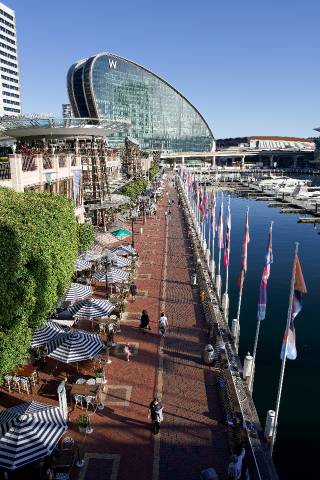 |
| Make | SONY |
| Model | ILCE-7RM5 |
| ISO Speed | 200 |
| Focal Length | 24.0mm |
| Aperture: | f/8.0 |
| Exposure | 1/400s |
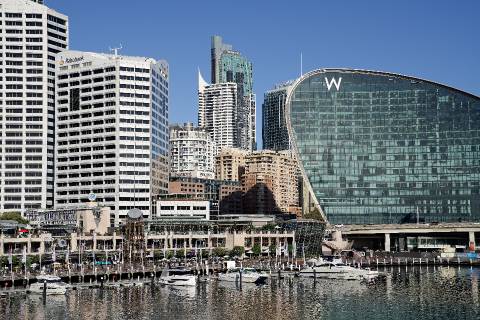 |
| Make | SONY |
| Model | ILCE-7RM5 |
| ISO Speed | 200 |
| Focal Length | 59.0mm |
| Aperture: | f/8.0 |
| Exposure | 1/1000s |
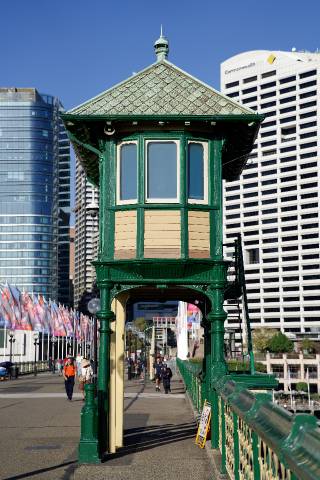 |
| Make | SONY |
| Model | ILCE-7RM5 |
| ISO Speed | 200 |
| Focal Length | 70.0mm |
| Aperture: | f/4.0 |
| Exposure | 1/3200s |
 |
| Make | SONY |
| Model | ILCE-7RM5 |
| ISO Speed | 200 |
| Focal Length | 70.0mm |
| Aperture: | f/9.0 |
| Exposure | 1/400s |
 |
| Make | SONY |
| Model | ILCE-7RM5 |
| ISO Speed | 200 |
| Focal Length | 70.0mm |
| Aperture: | f/5.6 |
| Exposure | 1/640s |
 |
| Make | SONY |
| Model | ILCE-7RM5 |
| ISO Speed | 200 |
| Focal Length | 20.0mm |
| Aperture: | f/8.0 |
| Exposure | 1/500s |
 |
| Make | SONY |
| Model | ILCE-7RM5 |
| ISO Speed | 200 |
| Focal Length | 20.0mm |
| Aperture: | f/8.0 |
| Exposure | 1/1000s |
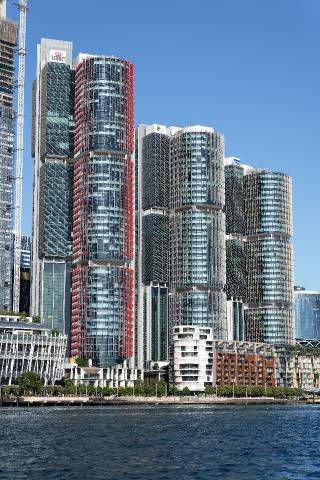 |
| Make | SONY |
| Model | ILCE-7RM5 |
| ISO Speed | 200 |
| Focal Length | 70.0mm |
| Aperture: | f/5.6 |
| Exposure | 1/1250s |
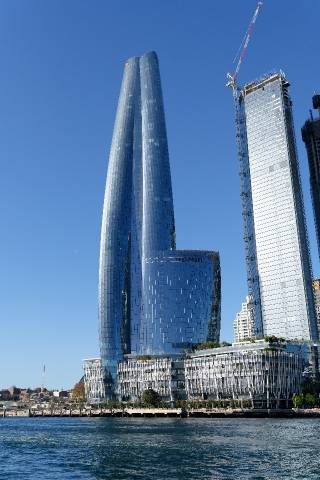 |
| Make | SONY |
| Model | ILCE-7RM5 |
| ISO Speed | 200 |
| Focal Length | 34.0mm |
| Aperture: | f/5.6 |
| Exposure | 1/1250s |
 |
| Make | SONY |
| Model | ILCE-7RM5 |
| ISO Speed | 200 |
| Focal Length | 20.0mm |
| Aperture: | f/8.0 |
| Exposure | 1/640s |
 |
| Make | SONY |
| Model | ILCE-7RM5 |
| ISO Speed | 640 |
| Focal Length | 20.0mm |
| Aperture: | f/4.0 |
| Exposure | 1/50s |
 |
| Make | SONY |
| Model | ILCE-7RM5 |
| ISO Speed | 640 |
| Focal Length | 20.0mm |
| Aperture: | f/4.0 |
| Exposure | 1/50s |
Competition
Many standard zoom lenses are available in Sony E-mount, but as of this review, the Sony FE 20-70mm f/4 G (shown to the left below) is unique with its 20mm wide setting. If you just want to have the extra reach at the wide end, you don't need to look any further. If you can live with 24mm at the wide end, there are at least 4 competitors. The most obvious is Sony's FE 24-105mm f/4 G OSS (center below). Needless to say, it offers quite some more range at the long end. It's a bigger lens, as you can see. While not as sharp, yours truly was actually quite happy with it during a recent trip to Japan. It has a better bokeh, but that's not difficult in this comparison. Then there's the rather old Zeiss Vario-Tesser T* 24-70mm f/4 OSS (to the right). It's worse than both Sony lenses, but if you can find a good deal, it's still good enough for 24mp cameras. Beyond Sony's own offerings, there's the Sigma 24-70mm f/2.8 DN DG ART and the Samyang AF 24-70mm f/2.8 FE in this price class. Obviously, these are faster lenses - and much bulkier/heavier (especially the Samyang).
 Visual comparison courtesy of camerasize.com.
Visual comparison courtesy of camerasize.com.
Verdict
The Sony FE 20-70mm f/4 G is one of the more exciting lenses released in recent years. It may be a new contender if we revisit the age-old question of which single lens to take on a remote island. However, this doesn't mean that it is a perfect lens. It relies heavily on digital auto-correction to do the job, but there's nothing wrong with this per se. However, Sony may have overdone - or, to be precise - underdone it a little when it comes to image distortions. In RAW images, the barrel distortions are nothing short of excessive at 20mm. Distortion correction is lossy, so auto-correction takes a toll on resolution. However, even so, the quality remains almost surprisingly high. The broader center quality is very good to excellent, and the outer image field is still good. As usual, the results are best in the broader middle zoom range. There's a tiny drop at 70mm, but the results are still sharp. Auto-correction is doing a nice job of reducing the vignetting. Lateral CAs are also quite low. If we had to point to a single major weakness that is image-affecting from an end-user perspective, it's the bokeh. However, you shouldn't expect a great bokeh from an f/4 standard zoom lens anyway, but this doesn't change the fact that the lens is worse than most in this respect. Returning to more positive aspects - as far as we can tell from sample images, the lens is pretty resistant to flare effects. And it can also produce pretty nice sun stars in night scenes.
The build quality of the FE 20-70mm f/4 G aligns with what you can expect from a modern G-class lens. It feels solid, and the used plastics are of high quality. The weather sealing may not have an IP rating, but it's certainly reassuring. The zoom and focus control rings operate smoothly. Videographers will certainly appreciate the focus breathing compensation support (in certain Sony cameras) as well as the clickless aperture option. The AF motor is both very quick and noiseless.
Overall, the Sony FE 20-70mm f/4 G is a winner unless you are into shallow depth-of-field photography. Especially outdoor enthusiasts will like the combination of image quality, compact size and low weight ... and, of course, the 20mm setting, which is its standout feature.
Optical Quality (42 megapixel):
★★★★★
Mechanical Quality:
★★★★★
What does this mean ?
|
|